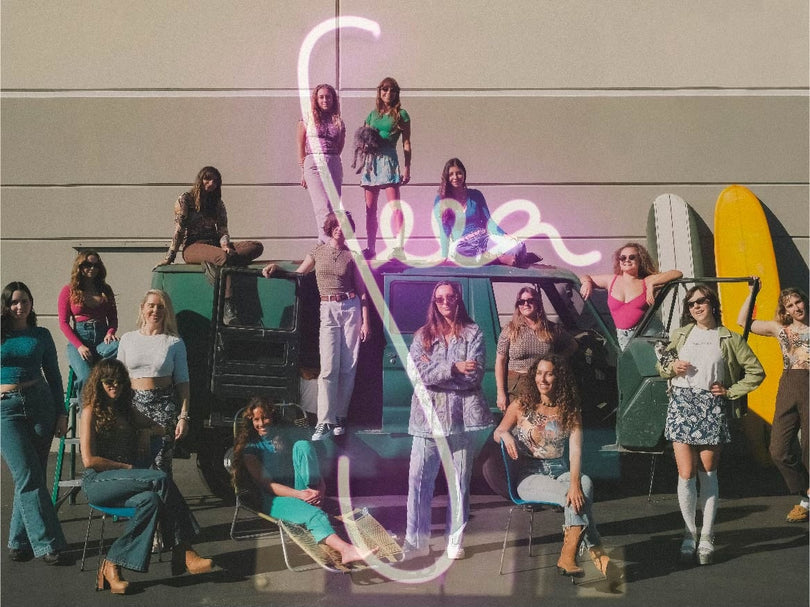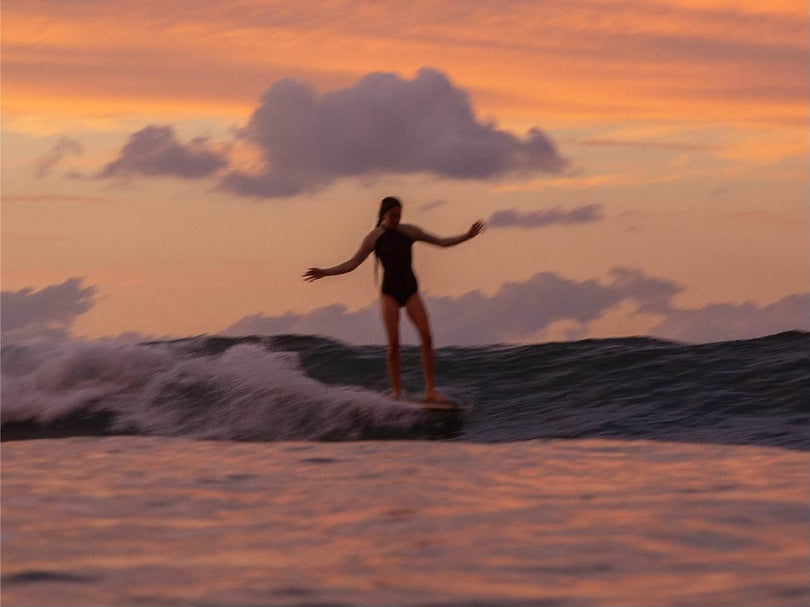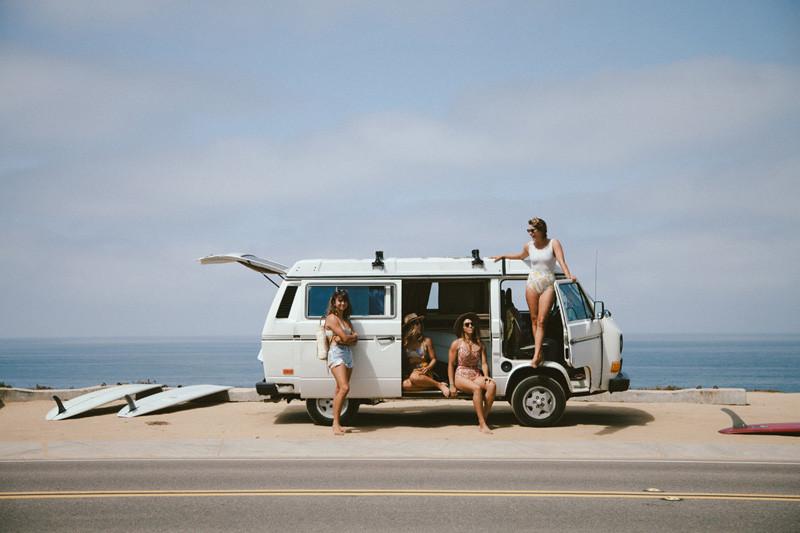 |
| Molly Mathiesen wears the Hermosa Surf Suit to dive with sharks and One Ocean Diving in Hawaii. Photo courtesy of Juan Oliphant, One Ocean Diving. |
A surfer’s first reaction to seeing a shark is to paddle as fast as you can away from it. But Mollie Mathiesen from Carlsbad, CA wanted to swim closer to these fascinating, terrifying and misunderstood creatures in the sea. That curiosity led her to discover One Ocean Diving's co-owner Ocean Ramsey (yes, that is her birth name) aka "the shark whisperer," who leads shark encounter tours off the coast of Oahu.
With aspirations to study marine biology and marine conservation in college, Mollie became fast friends with Ocean after her first dive while visiting Hawaii on vacation. Since then, she has hopped on their boat for countless dives and plans to make the underwater world her second home as an intern next summer.
The sharks that Mollie typically encountered in Hawaii were Galápagos sharks and Sand Bar sharks (not the Great Whites from Jaws), and her experience helped unravel common misconceptions about sharks as dangerous villains hunting us for food. We caught up with her to gain more insight into these mysterious ancient beings.
What is One Ocean Diving’s mission?
Mollie Mathiesen: Society has talked so low on sharks for years and made people so afraid of them just from a couple shark attacks. One Ocean Diving's mission is to change that perspective that people have and for them to understand the importance that sharks have in our ecosystem.
Sharks don't attack because they want to hurt people, it's all a huge misunderstanding. Every time we step into the ocean we are in marine life's territory, it's home to thousands of animals and we should respect that. Everyone working with One Ocean Diving wants society to look at sharks the way we do: as magnificent, beautiful creatures that have every right to swim freely as we do. Millions of sharks are being killed every day either for shark fin soup or just for sport so they need our help to speak up and help them.
 |
| Molly Mathiesen wears the Hermosa Surf Suit to dive with sharks and One Ocean Diving in Hawaii. Photo courtesy of Juan Oliphant, One Ocean Diving. |
While working with Ocean and Juan to take guests out on tours, what were some myths and misunderstandings that you learned that guests have about sharks?
Mollie Mathiesen: Not only among the guests but most everyone I talk to know little to nothing about sharks other than they are "monsters" and "attack people" when in fact they one of the most important contributors in our ecosystem. What most people don't know is that most of the food we eat, the goods we get, and the oxygen we breathe comes from the ocean, so the more sharks we have the healthier the reefs are that give us most of the things we need to survive. As most everyone knows in nature there are food chains and if you take out one of those living things then the whole chain comes crashing down, well that doesn’t change for marine life.
Sharks have stronger and more senses than humans do. One average human has five senses but sharks have two more incredible senses. Sharks feel all vibrations within every living thing to be able to detect where prey is, this is called Lateral Line symmetry. When swimmers or surfers are splashing or causing a lot of motion in the water this triggers a shark’s sensitivity to vibrations, making it think that it is "injured prey." This is the main reason why sharks attack, not because they want to on bite a human on purpose.
Most people have heard punch a shark in the nose if it gets too close. That’s because it’s the center of all their nerves called ampullae. They have thousands of small little pores to sense prey and detect a way to migrate. Out of thousands of fish traveling in a school, a shark can detect that one fish that is injured or carrying a disease. They sense that as easy prey and go after that one fish preventing the spread of diseases to coral reefs and other marine life. The decrease of sharks leads to the increase of diseases which causes other marine life to die, as well as coral reefs and other marine plants.
What types of sharks do you encounter?
Mollie Mathiesen: While diving we encounter mainly Galápagos sharks and Sand Bar sharks. Every once in a while a lucky tiger will come around and that's so special. At One Ocean Diving it's so important to have a relationship with the sharks so Juan and Ocean will do some tagging and tracking especially on the hurt or wounded ones just to see how they are doing. They also like to name the sharks they tag. For example, Roxy the tiger shark has a damaged jaw and Miss Aloha is a Galapagos shark they rescued from a fishing line wrapped around her gills.
 |
| Molly Mathiesen wears the Hermosa Surf Suit to dive with sharks and One Ocean Diving in Hawaii. Photo courtesy of Juan Oliphant, One Ocean Diving. |
Mollie Mathiesen: I have done both cage diving and free diving with these kinds of sharks and the experience is so eye-opening. This past summer we took some of my family out diving and my brother, Taylor Mathiesen, made a memorable comment that he thought the sharks were more aggressive while diving in the cage, almost like they didn't like it.
Being eye to eye within touching distance changes your perspective on these incredible creatures. Their actions are so predictable that I feel safer diving with them then I do walking by myself in an unfamiliar area. Being out in the warm ocean seeing nothing but clear blue for miles and having sharks swimming all around has no words to describe the feeling.
Has there ever been a negative experience on the boat?
Mollie Mathiesen: Juan and Ocean really make sure that everyone is 100% safe while diving. If anything bad were to happen between a shark and human One Ocean Diving would not be a company anymore. Ocean has spent years and years studying the beauty of these creatures and each of their behaviors so each time her or Juan puts anyone in the ocean with up to 15 sharks they know that everyone will be completely safe and nothing with happen.
How has this experience changed your perception, education and feelings towards sharks? How have you seen it change other people’s feelings about sharks?
Mollie Mathiesen: The experience to dive with sharks and work with One Ocean Diving to make a difference is what I've always wanted since I could swim. I wake up every day wanting to go dive and go to bed planning on how to spread more word of their importance. I have learned more than I could ever imagine from Juan and Ocean. The more you know about sharks and even anything in the ocean, the less scary they appear.
I got the amazing experience to take my four best friends out diving while vacationing in Oahu this summer. They have constantly heard me going on and on about how important sharks are and how amazing it is to be swimming freely in their ocean with them so they were excited to see for themselves what I was really talking about. Being with them they said changed their perspective. Yeah, hearing facts about them made it less scary, but being underwater seeing it in person made the fear go away. At One Ocean Diving that is just how we want everyone to feel.
Thank you Mollie! Go to One Ocean Diving's website to book a dive, or visit their Instagram.
MORE ENVIRONMENTAL STORIES:







